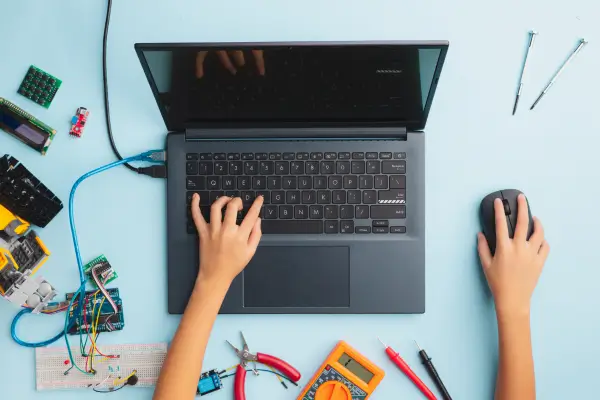In a world increasingly driven by technology, the way we educate our children must evolve to meet the demands of the digital age. One significant trend gaining momentum is the use of educational robots to teach coding to kids. These robots not only provide a fun and interactive way to learn programming but also help develop critical skills such as problem-solving, creativity, and collaboration.
As we delve deeper into the realm of educational robots, we’ll explore their importance, the benefits they offer, and how they can be effectively integrated into educational settings. Let’s embark on this journey into the fascinating intersection of robotics and coding education.
What Are Educational Robots?
Definition and Examples
Educational robots are programmable devices designed to facilitate learning in various subjects, particularly in science, technology, engineering, and mathematics (STEM). They serve as engaging tools that allow children to grasp complex concepts through hands-on experience. Examples of popular educational robots include:
- LEGO Mindstorms: A versatile platform that enables kids to build and program their own robots using LEGO bricks.
- Ozobot: A tiny robot that follows lines and colors, allowing young learners to code using color codes and basic programming languages.
- Sphero: A spherical robot that can be programmed via apps, encouraging creativity and coding skills through game-like activities.
Features and Functionalities
Educational robots often come equipped with various features that enhance learning. These may include:
- Programmable Interfaces: Kids can write code using block-based programming or more advanced languages depending on their age and skill level.
- Sensors and Actuators: Many robots have sensors (e.g., light, sound) that allow them to interact with their environment, creating a dynamic learning experience.
- Connectivity: Many robots can connect to tablets or computers, enabling access to a range of programming tools and educational resources.
The Importance of Coding in Today’s World
The Role of Coding in Various Industries
As technology continues to evolve, coding has become a fundamental skill in numerous fields, including healthcare, finance, entertainment, and engineering. Understanding the basics of programming can open doors to various career opportunities, making it essential for children to learn coding early.
Benefits of Learning Coding at an Early Age
Introducing coding to children can yield numerous benefits:
- Enhances Problem-Solving Skills: Coding teaches kids how to break down complex problems into manageable parts, fostering analytical thinking.
- Promotes Creativity: Programming allows children to create their own games, animations, and applications, encouraging creative expression.
- Encourages Collaboration: Many coding projects require teamwork, teaching kids the importance of communication and collaboration.
How Coding Fosters Problem-Solving and Critical Thinking Skills
Learning to code involves understanding algorithms, logic, and the iterative process of debugging. These skills are directly transferable to real-world problem-solving situations, making coding an invaluable asset for future success.
How Educational Robots Facilitate Learning
Interactive and Engaging Learning Experiences
Educational robots transform traditional learning into interactive experiences. Children are naturally curious, and robots captivate their attention while providing an engaging platform for learning. For instance, a child coding a robot to navigate an obstacle course gains immediate feedback on their coding skills, making the learning process dynamic and exciting.
Hands-On Coding Practice Through Robotics
Robots enable hands-on experience with coding, allowing kids to see the direct consequences of their programming decisions. This practical approach reinforces theoretical concepts, making them easier to understand and retain. For example, when a child programs a robot to dance, they learn about sequencing, loops, and conditionals in a tangible way.
Real-Time Feedback and Troubleshooting Opportunities
One of the key advantages of using robots in education is the immediate feedback they provide. When a robot fails to perform as expected, students learn to troubleshoot and problem-solve in real time. This process not only builds resilience but also enhances critical thinking skills as they explore different solutions.
Popular Educational Robots for Kids
Overview of Notable Educational Robots
- LEGO Mindstorms
- Features: Programmable with a user-friendly interface; compatible with various sensors and motors.
- Age Appropriateness: Best suited for ages 10 and up.
- Success Stories: Many schools use LEGO Mindstorms for robotics clubs, resulting in high student engagement and interest in STEM fields.
- Ozobot
- Features: Small, mobile robot that follows lines and colors; utilizes color coding for programming.
- Age Appropriateness: Ideal for ages 5 and up.
- Success Stories: Teachers report significant improvement in students’ understanding of basic coding concepts through interactive Ozobot activities.
- Sphero
- Features: Spherical robot that can be programmed using various apps; encourages creative challenges.
- Age Appropriateness: Suitable for ages 8 and up.
- Success Stories: Sphero has been used in classrooms to create coding games that promote teamwork and creative problem-solving.
Integrating Educational Robots into the Curriculum
Tips for Teachers on Incorporating Robots into Lesson Plans
Integrating educational robots into the curriculum requires thoughtful planning. Here are some tips for educators:
- Start with Clear Learning Objectives: Define what you want students to achieve through the use of robots. Align these objectives with curriculum standards.
- Create Engaging Projects: Design projects that allow students to apply coding skills in fun and creative ways, such as building and programming robots to complete challenges.
- Encourage Collaboration: Facilitate group work to promote teamwork, where students can learn from each other and share their insights.
Examples of Coding Projects Using Educational Robots
- Obstacle Course Challenge: Students program their robots to navigate through a series of obstacles, enhancing their understanding of navigation and programming logic.
- Robot Dance Party: Children code their robots to perform choreographed dance routines, integrating music and movement with programming skills.
- Storytelling with Robots: Students create narratives and program robots to act out their stories, combining creativity with coding.
Potential Challenges and Solutions
While integrating educational robots can be rewarding, challenges may arise:
- Limited Resources: Schools may face budget constraints. Solution: Explore grants, donations, or community partnerships to acquire robots.
- Teacher Training: Educators may need training in coding and robotics. Solution: Provide professional development workshops to equip teachers with necessary skills.
- Student Resistance: Some students may be hesitant to engage with technology. Solution: Foster a supportive environment that encourages experimentation and emphasizes the fun aspect of coding.
The Future of Educational Robotics
Trends in Educational Technology and Robotics
The landscape of educational technology is constantly evolving. Emerging trends include:
- Artificial Intelligence (AI): AI integration in educational robots can enhance personalization, allowing robots to adapt to individual learning styles and paces.
- Virtual Reality (VR): Combining VR with robotics can create immersive learning experiences, enabling students to interact with coding in virtual environments.
- Cross-Disciplinary Learning: Educational robots can bridge subjects, integrating coding with art, science, and mathematics to provide a holistic learning experience.
Predictions for the Role of Robots in Future Education
As technology continues to advance, the role of educational robots is expected to expand. Future predictions include:
- Increased Accessibility: Advances in technology will likely make educational robots more affordable and accessible to a wider range of schools and communities.
- Greater Emphasis on Soft Skills: As automation rises, educational robots will play a crucial role in teaching students soft skills like communication, teamwork, and creativity—skills that are increasingly valued in the workforce.
The Potential Impact on Job Skills and Workforce Readiness
As students engage with educational robots, they are not just learning to code; they are preparing for a workforce that increasingly values technical skills and problem-solving abilities. By cultivating these skills early on, we empower the next generation to thrive in a rapidly changing job market.
Conclusion
The rise of educational robots marks a significant shift in how we approach coding education for children. By providing interactive, engaging, and hands-on experiences, these robots help foster essential skills that will benefit students in both their academic and future professional lives. As we embrace this innovative educational tool, we must encourage parents and educators to explore the vast possibilities that robotics offers.
Let’s inspire our children to become the innovators of tomorrow by providing them with the tools and knowledge they need today. By integrating educational robots into learning environments, we can create a future where coding is not just a skill but a foundational element of every child’s education.




